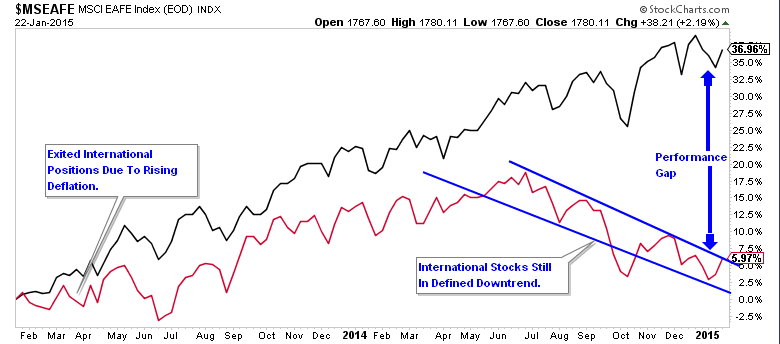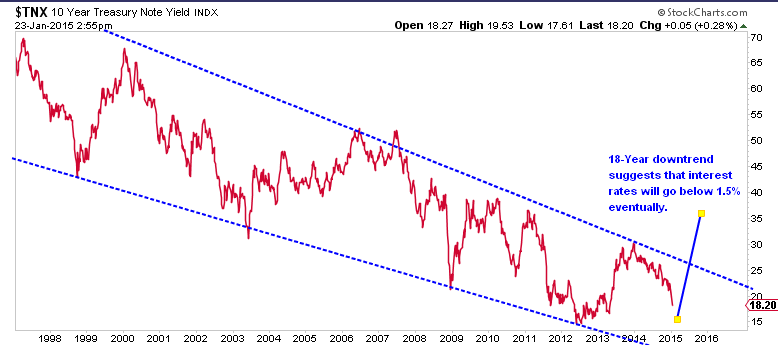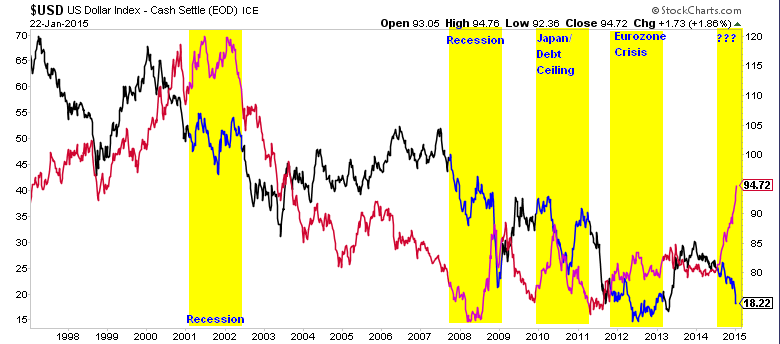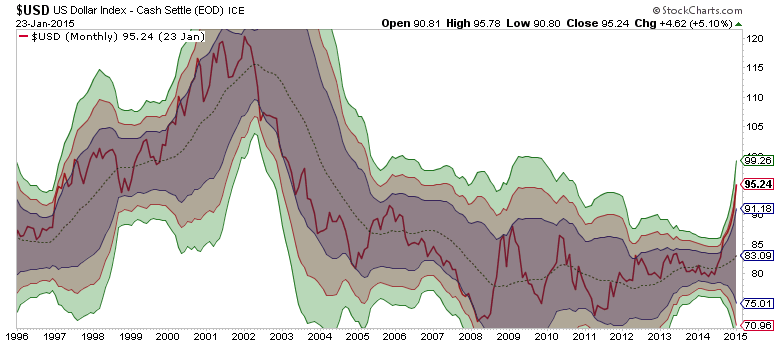Gold
For over two years now I have consistently recommended excluding gold and gold-related holdings from your portfolio. This advice has paid out extremely well over that time by reducing portfolio drag as deflationary pressures have continued to mount globally.
(Note: While there is a large advocacy for owning gold my investment philosophy is quite simple, gold is an asset class to own when it is trending positively. That has not been the case for a long time. However, if the world does end in economic chaos, it will be "gunpowder and lead" that will be the asset classes to own.)
Currently, gold has experienced a bit of a revival as expectations once again rise that the ECB's QE program will spark inflation in Europe, that in turn will drive gold prices higher. As the chart below shows, gold has indeed turned up but not yet enough to break out of the long-term downtrend that has confined gold for quite some time.
My suspicions are that deflation will continue to rule Europe for the quarters ahead. It is highly unlikely, given the current size and scope of the ECB's QE program, that it will have any significant impact on inflation in Europe.
For now, gold is back on the watch list for the moment, but it is not time to buy it just yet.
Gold Miners
Since the price of gold directly affects the profitability of operations from gold mining companies, it should be no surprise that there is an extremely high correlation between the commodity and the miners. However, it is important to remember that the commodity price is one thing, for companies they have operational costs, debt, regulations and a variety of other inputs that affect their profitability. In the near term, (ARCA:gold miners), like gold, remain currently constrained in a long-term downtrend that shows little sign of abating at the current time.
International
Another area that we previously recommended getting out of all together was International equities. As with gold, the rising deflationary tide in the Eurozone was undeniable, even though the mainstream analysis hoped otherwise. The reduction in international exposure played to the benefit of domestically concentrated portfolios. However, that may be about to change.
While international equities are still confined to a very distinct downtrend, the decline in the euro will likely begin to have further impacts on US exports and the profits of multi-national companies. In this regard, the relative performance between international stocks and domestic companies may improve making international exposure worth adding back to portfolios.
However, currently, there is NO EVIDENCE that is the case. Therefore, like gold, I will keep international stocks on the watch list for now and make an addition to the portfolio model when the trend becomes more positive.
Emerging Markets
I have been negative on emerging market stocks for a very long time and have consistently recommended eliminating all exposure to this area. That remains the case currently.
There is nothing in the emerging market space currently, fundamentally or technically, that suggests that performance is turning more positive. From an economic standpoint, these countries remain at the mercy of the three largest trading partners (U.S., Europe and Japan), which are all suffering serial deflationary slowdowns. While there are many hopes that the U.S. will remain an island of strength in the year ahead, the reality is that the U.S. economy is likely to slow back toward 2% annualized growth in the quarters ahead.
Interest Rates
As with the annual migration of birds to the south for the winter, there has been an annual call for the end of the "bond bull" market and the steady rise of interest rates. This has yet to case, of course, as deflationary pressures continue to swamp the global economy. (Something I pointed out specifically in 2013).
As you can see in the chart above, rates have been contained in a steady downtrend for the past 18 years. Without making any predictions, the current downtrend suggests that interest rates on the U.S. 10-Year treasury will fall below 1.5% between now and the end of 2016. This would coincide with the onset of a recession sometime early to mid-2016.
US Dollar
The recent surge in the U.S. dollar also has some very interesting dynamics. While many people look at the surging U.S. dollar as a sign of economic strength, it may actually be indicating something much different, particularly when viewed in conjunction with the steady decline in interest rates.
If you notice in the chart above, a rapidly strengthening US dollar has tended to lead to recession, crisis and bad market outcomes in the past. With the markets already grossly extended, deflationary pressures rising and economies generally weak -- there is a high risk that something could break. It will be worth paying attention a bit more closely to your money over the next couple of quarters if these trends persist.
As an aside, the dollar is currently GROSSLY EXTENDED above its long-term mean. If you are long dollar denominated assets, it might be sensible to "trim a little" around the edges and book some gains. As shown in the chart below, the dollar is currently 4-standard deviations above its 21-month moving average. This is a 1-in-100 year event and is highly unsustainable.
Who's Leading The S&P 500
In the "Who's leading the S&P 500" category, it is not surprising to still find defensive issues remaining in charge as they have been over most of the past year. Utilities continue to be strong performers, along with Healthcare, and Staples.
The Discretionary sector has also snuck into leadership along with Industrials. However, I suggest remaining extremely cautious on overweighting these two sectors as they are very economically sensitive. With exports likely to be hurt in the next couple of quarters, due to the strong rise in the U.S. dollar, industrials may come under pressure quickly.
I stated last week that Small and Mid-Capitalization stocks were improving but not yet ready to add to portfolios. That remains the case currently, and I would like to wait another week to see if performance continues to improve before recommending an increase in the portfolio model.
The big laggards continue to be Emerging Markets, Energy, Financials, Technology and Basic Materials. It is recommended that you remain underweight these sectors currently.
Oil And Energy
In regards to oil and energy-related stocks, it is very likely that we have not seen the bottom in oil prices or energy stocks yet. Therefore, it may be a bit early to begin bottom fishing at this point as rig counts are in the early stages of their potential decline and will likely begin dropping rapidly over the next couple of quarters.
The reality is that we may soon be witnessing "liquidations" in this sector rather than "acquistions." Make sure you are not fishing in the "liquidation" pond.









